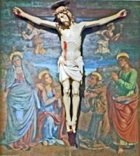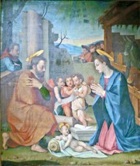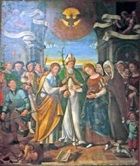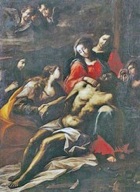

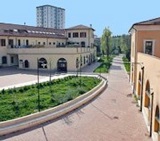
The Pinacoteca was moved in 2009 to the new Centro Arti Opificio Siri (c.a.o.s.), the purpose-built museum complex in the ex-Opificio Siri (the factory of the Società Italiana Ricerche Industriali). The signs take you to the Museo d' Arte Moderna e Contemporanea "Aurelio De Felice": the small but important collection of medieval and Renaissance paintings is on the upper floor of this building.
San Cleto Triptych (ca. 1400)
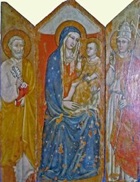
The triptych was documented in the now-demolished church of San Cleto in 1726. This church was dedicated to Pope Anacletus I (ca. 79-91 AD), who is depicted here holding a Cross, an allusion to the fact that he was credited with the formation of the Order of Crosiers. (There is a painting (16th century) of St Anacletus founding the order in the Oratorio dei Crociferi (13th century) in Venice).
The Order of Crosiers was dedicated to the care of the poor and of pilgrims. San Cleto in Terni was used by the Confraternita di San Nicandro, which was similarly dedicated to the care of the poor and of pilgrims.
Mystic marriage of St Catherine (1466)
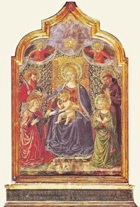
This image was highly venerated and normally kept behind a screen, but it was displayed for a short period each year for worship. It was kept in a side chapel until 1680, when Ludovico Rustici arranged for it to be translated to a new wooden structure that he had commissioned in the newly rebuilt presbytery of the church.
The image passed to the Commune when the Poor Clares, who had moved to Santa Maria dell’ Oro in 1862, left in 1895. A dispute with the Rustici family over its ownership was resolved in favour of the Commune in 1899. Documentation at the time of the litigation reveals that the panel was part of a triptych. However, the side panels are no longer known and there is no other surviving record of them.
Gonfalone (15th century)
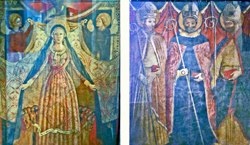
This two-sided standard is of unknown provenance, but was probably used in processions of supplicants seeking protection from the plague.
-
✴The front of the standard depicts the Madonna della Misericordia against a black background, with God the Father above. The Madonna shelters a number of female supplicants under her cloak.
-
✴Three standing bishop saints are depicted on the reverse. These are usually identified as SS Valentine, Anastasius and Proculus, although the central figure is more likely to be St Augustine.
The attributions of the work to the Sienese artist Pietro di Giovanni di Ambrogio or to Paolo da Visso are both uncertain.
Crucifix (15th century)
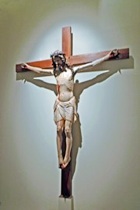
Pala dei Francescani (1483-5)
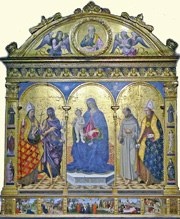
The inscription at the bottom of the central panel of this triptych records that Father Dionisio di Giovanni, the Procurator for the friars of San Francesco, Terni, commissioned the work and gives the date as 1485. The triptych survived in its original frame on the high altar of the church even after the suppression of the convent, but was removed in 1896. It was restored in 1996.
The work was first attributed to Pier Matteo d' Amelia in 1924. However, the attribution remained disputed until 1985, when two documents were found in the archives of Terni:
-
✴a contract dated 1483 between Dionisio di Giovanni and Pier Matteo d' Amelia for an altarpiece; and
-
✴a record of the satisfactory delivery of the work in 1485.
The main panels of the triptych depict:
-
✴the Madonna and Child enthroned;
-
✴SS Bonaventure and John the Baptist on the left; and
-
✴SS Francis and Louis of Toulouse on the right.
SS Bonaventure and Louis of Toulouse each wears the Franciscan habit under his bishop’s clothes. St Bonaventure had been canonised in 1482, only a year before the triptych was commissioned.
The pilasters depict:
-
✴SS Antony of Padua, Valentine and Margherita of Cortona (who had not been canonised at the time that the work was commissioned) on the left; and
-
✴SS Bernardino of Sienna, Sebastian and Clare on the right.
The lunette depicts God the Father with angels and the predella contains scenes from the life of Christ:
-
✴the Nativity;
-
✴the Adoration of the Magi;
-
✴the Crucifixion;
-
✴the Resurrection; and
-
✴Christ’s descent into limbo to resurrect the saved.
Madonna and Child with saints (15th century)

This fresco was detached from the lunette over the central portal of Santa Maria delle Grazie in the 17th century and placed in the cloister. It was transferred to the Pinacoteca in 1876.
The fresco is sometimes attributed to Pier Matteo d’ Amelia, but has been heavily repainted. It depicts the Madonna and Child with SS Francis and Bernardino of Siena.
Crucifixion with SS Francis and Bernardino (1497)
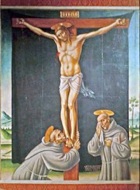
Crucifixion (15th and 16th centuries)
-
✴the wooden Crucifix (15th century), which is attributed to Giovanni Tedesco; and
-
✴the frescoed backdrop (16th century), which is attributed to Giovanni di Pietro, lo Spagna. This depicts the Virgin and SS Mary Magdalene, Francis and John the Evangelist, with an image of San Francesco, Assisi behind the last two saints. The composition is based on the fresco (1502) by Perugino from the Franciscan Convento di Monte Ripido, Perugia, which is now in the Galleria Nazionale, Perugia.
Altarpieces (16th century)
These altarpieces from Santa Maria delle Grazie include the following:
-
✴the Madonna and Child with saints and angels, which is attributed to Domenico Alfani (not on display when I visited in June 2009). It depicts the Madonna and Child with SS Antony of Padua and Louis of Toulouse. Two angels hold a crown over the head of the Madonna, and the donor kneels to the left.
-
✴the Deposition, by a follower of Livio Agresti. This work is modelled on the Deposition (ca. 1545) by Daniele da Volterra in the Cappella Orsini of the Chiesa della Trinità del Monte, Rome.
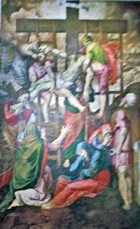
Madonna and Child with St Anne (16th century)
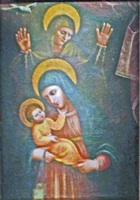
Madonna and Child with saints (16th century)
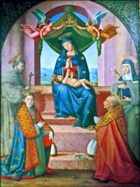
Marriage of the Virgin (16th century)
Christ with saints (16th century)
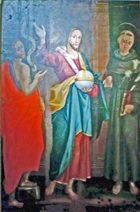
Martyrdom of Gorcum (after 1675)

This panel is a copy of one of the prints depicting the scene (as yet unpublished) that were circulated after the beatification. The Nicoletti family, whose arms appear at the lower left of the panel, probably commissioned it. A member of this family, Gabriele Nicoletti, wrote a book (1650) entitled “Supplimento delle guerre di Fiandra ” that described later hostilities in Holland (in 1623-1625): it seems likely that the beatification in 1675 of these martyrs from earlier hostilities prompted his family to commission the panel in his memory.
(The same subject is depicted in a panel in Santa Maria dell’ Oro).
[I am grateful to Dr. Roy Tepe for sending me much of this information.]
Lamentation (17th century)
Madonna and Child with saints (17th century)
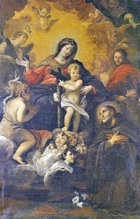
Silvestro Spada (18th century)
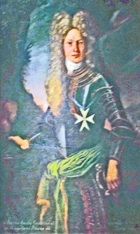
Museum catalogue:
“Pinacoteca Comunale ‘Orneore Metelli’ di Terni: Dipinti, Sculture, Stampe e Arredi dall’ VIII al XIX Secolo”, C. Fratini (Ed.), Milan (2000).
Return to Museums of Terni.
Return to Art in Terni.
Return to Walk II.
